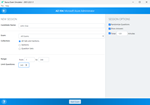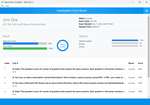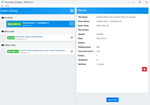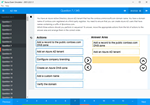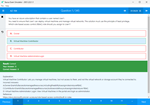Download Installation, Storage, and Compute with Windows Server 2016.70-740.TestKing.2019-01-18.152q.tqb
| Vendor: | Microsoft |
| Exam Code: | 70-740 |
| Exam Name: | Installation, Storage, and Compute with Windows Server 2016 |
| Date: | Jan 18, 2019 |
| File Size: | 4 MB |
How to open TQB files?
Files with TQB (Taurus Question Bank) extension can be opened by Taurus Exam Studio.
Purchase
Coupon: TAURUSSIM_20OFF
Discount: 20%
Demo Questions
Question 1
Note: This question is part of a series of questions that present the same scenario. Each question in the series contains a unique solution that might meet the stated goals. Some question sets might have more than one correct solution, while others might not have a correct solution.
After you answer a question in this section, you will NOT be able to return to it. As a result, these questions will not appear in the review screen.
You have a server named Server1 that runs Windows Server 2016.
Server1 hosts a line-of-business application named App1. App1 has a memory leak that occasionally causes the application to consume an excessive amount of memory.
You need to log an event in the Application event log whenever App1 consumes more than 4 GB of memory.
Solution: You create a performance counter alert data collector.
Does this meet the goal?
- Yes
- No
Correct answer: A
Question 2
Note: This question is part of a series of questions that present the same scenario. Each question in the series contains a unique solution that might meet the stated goals. Some question sets might have more than one correct solution, while others might not have a correct solution.
After you answer a question in this section, you will NOT be able to return to it. As a result, these questions will not appear in the review screen.
You have a server named Server1 that runs Windows Server 2016.
Server1 hosts a line-of-business application named App1. App1 has a memory leak that occasionally causes the application to consume an excessive amount of memory.
You need to log an event in the Application event log whenever App1 consumes more than 4 GB of memory.
Solution: You create a system configuration information data collector.
Does this meet the goal?
- Yes
- No
Correct answer: B
Question 3
You have a Hyper-V host named Server1 that runs Windows Server 2016.
Server1 has a virtual machine named VM1. VM1 is configured to run the Docker daemon.
On VM1, you have a container network that uses transparent mode.
You need to ensure that containers that run on VM1 can obtain IP addresses from DHCP.
What should you do?
- On VM1, run Get-VMNetworkAdapter-VMName VM1 | Set-VMNetworkAdapter –MacAddressSpoofing On.
- On VM1, run docker network connect.
- On Server1, run docker network connect.
- On Server1, run Get-VMNetworkAdapter –VMName VM1 | Set-VMNetworkAdapter –MacAddressSpoofing On.
Correct answer: D
Explanation:
To use DHCP for IP assignment on a virtual container host enable MACAddressSpoofing If the container host is virtualized, and you wish to use DHCP for IP assignment, you must enable MACAddressSpoofing on the virtual machine's network adapter. Otherwise, the Hyper-V host will block network traffic from the containers in the VM with multiple MAC addresses. You can enable MACAddressSpoofing with this PowerShell command:PS C:\> Get-VMNetworkAdapter -VMName ContainerHostVM | Set-VMNetworkAdapter -MacAddressSpoofing OnReferences:https://docs.microsoft.com/en-us/virtualization/windowscontainers/container-networking/advanced To use DHCP for IP assignment on a virtual container host enable MACAddressSpoofing
If the container host is virtualized, and you wish to use DHCP for IP assignment, you must enable MACAddressSpoofing on the virtual machine's network adapter. Otherwise, the Hyper-V host will block network traffic from the containers in the VM with multiple MAC addresses.
You can enable MACAddressSpoofing with this PowerShell command:
PS C:\> Get-VMNetworkAdapter -VMName ContainerHostVM | Set-VMNetworkAdapter -MacAddressSpoofing On
References:
https://docs.microsoft.com/en-us/virtualization/windowscontainers/container-networking/advanced
Question 4
You have a server that runs Windows Server 2016.
The server contains a storage pool named Pool1. Pool1 contains five physical disks named Disk1, Disk2, Disk3, Disk4, and Disk5.
A virtual disk named VirtualDisk1 is stored in Pool1. VirtualDisk1 uses the parity storage layout.
Disk3 fails.
You need to remove Disk3 from Pool1.
Which two commands should you run? Each correct answer presents part of the solution.
- Update-StoragePool –FriendlyName Pool1
- Set-ResiliencySetting –StoragePool Pool1 –PhysicalDiskRedundancyDefault 4
- Reset-PhysicalDisk –FriendlyName Disk3
- Set-PhysicalDisk –FriendlyName Disk3 –Usage Retired
- Remove-PhysicalDisk –FriendlyName Disk3
Correct answer: DE
Question 5
You have an Active Directory domain named Contoso.com. The domain contains servers named Server1, Server2 and Server3 that run Windows Server 2016.
Server1 and Server 2 are nodes in a Hyper-V cluster named Cluster1. You add a Hyper-V Replica Broker role named Broker1 to Cluster1.
Server3 is Hyper-V server. A virtual machine VM1 runs on Server3.
Live Migration is enabled on all three servers and it is configured to use Kerberos authentication only.
You need to ensure that you can perform the migration of VM1 to Server2.
What should you do?
- Modify the Storage Migration settings on Server3.
- Modify the Cluster permissions for Cluster1.
- Add the Server3 computer account to the Replicator group on Server1 and Server2.
- Modify the Delegation settings of the Server3 computer account.
Correct answer: D
Explanation:
If you have decided to use Kerberos to authenticate live migration traffic, configure constrained delegation. This involves modifying the Delegation settings of the source server, which is Server3 in this instance. References:https://technet.microsoft.com/en-us/library/jj134199(v=ws.11).aspx#BKMK_Step1 If you have decided to use Kerberos to authenticate live migration traffic, configure constrained delegation. This involves modifying the Delegation settings of the source server, which is Server3 in this instance.
References:
https://technet.microsoft.com/en-us/library/jj134199(v=ws.11).aspx#BKMK_Step1
Question 6
You have a Windows Server 2016 Hyper-V failover cluster that contains two nodes named Node1 and Node2.
On Node1, you create a virtual machine named VM01 by using Hyper-V Manager.
You need to configure VM01 to move to Node2 automatically if Node1 becomes unavailable.
What should you do?
- From Failover Cluster Manager, run Configure Role actions.
- From Hyper-V Manager, click VM01, and click Enable Replication.
- From Hyper-V Manager, click Node1, and then modify the Hyper-V settings.
- From Windows PowerShell, run the Enable-VMReplicationcmdlet.
Correct answer: A
Explanation:
If you have VMs on cluster nodes that are not currently cluster resources, it's a simple process to make them highly available, provided they're using cluster storage (such as a Cluster Shared Volume):Start Failover Cluster Manager. Expand the cluster Roles. Select the Configure Role... action. Click Next to the introduction wizard. In the Select Role dialog box, select Virtual Machine as the type and click Next. Select all the virtual machines you want to make highly available and click Next. Click Next to the confirmation. Click Finish to the report, which should show Success for all. If there are Warnings, check and resolve problems if needed References:http://windowsitpro.com/hyper-v/make-vm-highly-available-windows-server-2012 If you have VMs on cluster nodes that are not currently cluster resources, it's a simple process to make them highly available, provided they're using cluster storage (such as a Cluster Shared Volume):
- Start Failover Cluster Manager.
- Expand the cluster Roles.
- Select the Configure Role... action.
- Click Next to the introduction wizard.
- In the Select Role dialog box, select Virtual Machine as the type and click Next.
- Select all the virtual machines you want to make highly available and click Next.
- Click Next to the confirmation.
- Click Finish to the report, which should show Success for all. If there are Warnings, check and resolve problems if needed
References:
http://windowsitpro.com/hyper-v/make-vm-highly-available-windows-server-2012
Question 7
Your network contains three Hyper-V hosts. You add all of the hosts to a cluster.
You need to create highly available storage spaces that connect to directly attached storage on the hosts.
Which cmdlet should you use?
- Add-ClusterDisk
- Enable-ClusterStorageSpacesDirect
- Update-ClusterVirtualMachineConfiguration
- Set-StoragePool
Correct answer: B
Question 8
You have four servers named Server1, Server2, Server3, and Server4 that run Windows Server 2016. Each server has a single 4-TB SATA hard disk.
To each server you attach a new 4-TB SATA hard disk.
You need to create a new storage cluster that uses Storage Spaces Direct. The storage pool must contain all of the new disks.
Which command should you run before you enable Storage Space Direct?
- Add-ClusterSharedVolume –Name “Disk 1” –Cluster Cluster1
- New-Cluster –Name Cluster1 –Node ‘Server1’, ‘Server2’, ‘Server3’, ‘Server4’ -NoStorage
- Get-ClusterAvailableDisk –Cluster Cluster1 | Add-ClusterDisk
- New-ClusterStorageEnclosure –id 1 –name Cluster1 –type jbod –ConnectionString “Server1,Server2,Server3,Server4”
Correct answer: B
Question 9
Note: This question is part of a series of questions that use the same scenario. For your convenience, the scenario is repeated in each question. Each question presents a different goal and answer choices, but the text of the scenario is exactly the same in each question in this series.
Your network contains an Active Directory domain named contoso.com. The functional level of the forest and the domain is Windows Server 2008 R2. All servers in the domain run Windows Server 2016 Standard. The domain contains 300 client computers that run either Windows 8.1 or Windows 10.
The domain contains nine servers that are configured as shown in the following table.

The virtual machines are configured as follows:
- Each virtual machine has one virtual network adapter.
- VM1 and VM2 are part of a Network Load Balancing (NLB) cluster.
- All of the servers on the network can communicate with all of the virtual machines.
On Server4, you plan to provision a new volume that will be used to create large, fixed-size VHDX files.
Which type of file system should you use for the new volume to minimize the amount of time required to create the VHDX files?
- ReFS
- NTFS
- CSVFS
- exFAT
Correct answer: A
Question 10
Note: This question is part of a series of questions that use the same scenario. For your convenience, the scenario is repeated in each question. Each question presents a different goal and answer choices, but the text of the scenario is exactly the same in each question in this series.
Your network contains an Active Directory domain named contoso.com. The functional level of the forest and the domain is Windows Server 2008 R2. All servers in the domain run Windows Server 2016 Standard. The domain contains 300 client computers that run either Windows 8.1 or Windows 10.
The domain contains nine servers that are configured as shown in the following table.

The virtual machines are configured as follows:
- Each virtual machine has one virtual network adapter.
- VM1 and VM2 are part of a Network Load Balancing (NLB) cluster.
- All of the servers on the network can communicate with all of the virtual machines.
You need to minimize the likelihood that a virtual machine running malicious code will consume excessive resources on Server5.
What should you do?
- Configure the virtual machines as shielded virtual machines.
- Run the Set-VMProcessor cmdlet and specify the EnableHostResourceProtection parameter.
- Run the Set-VMProcessor cmdlet and specify the MaximumCountPerNumaNode parameter.
- Configure VM Network Adapter Isolation.
Correct answer: B
HOW TO OPEN VCE FILES
Use VCE Exam Simulator to open VCE files

HOW TO OPEN VCEX FILES
Use ProfExam Simulator to open VCEX files


ProfExam at a 20% markdown
You have the opportunity to purchase ProfExam at a 20% reduced price
Get Now!